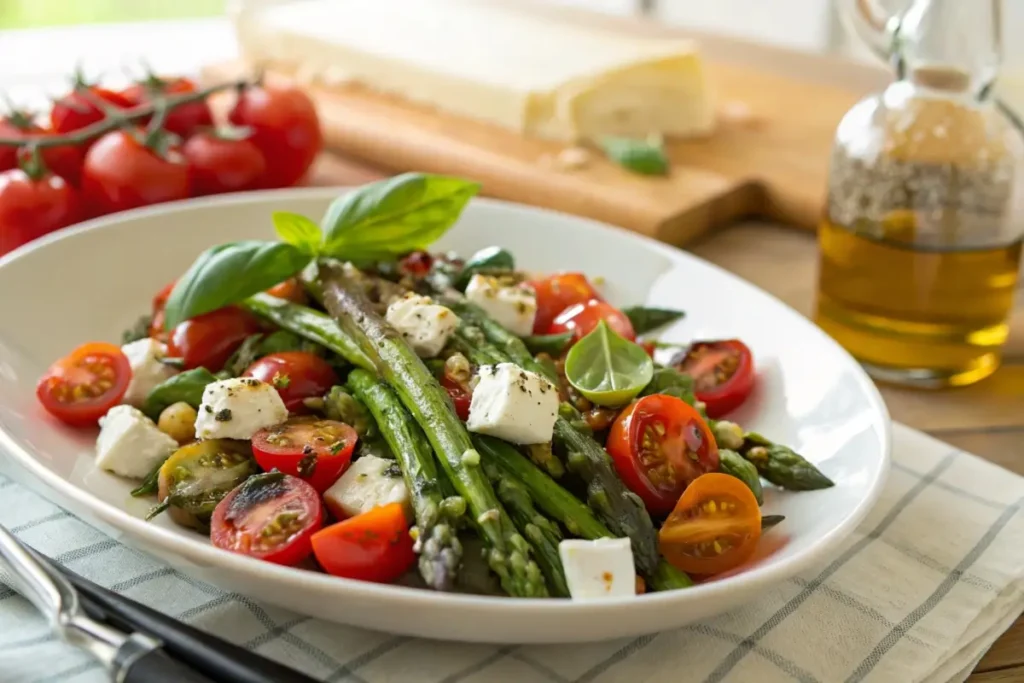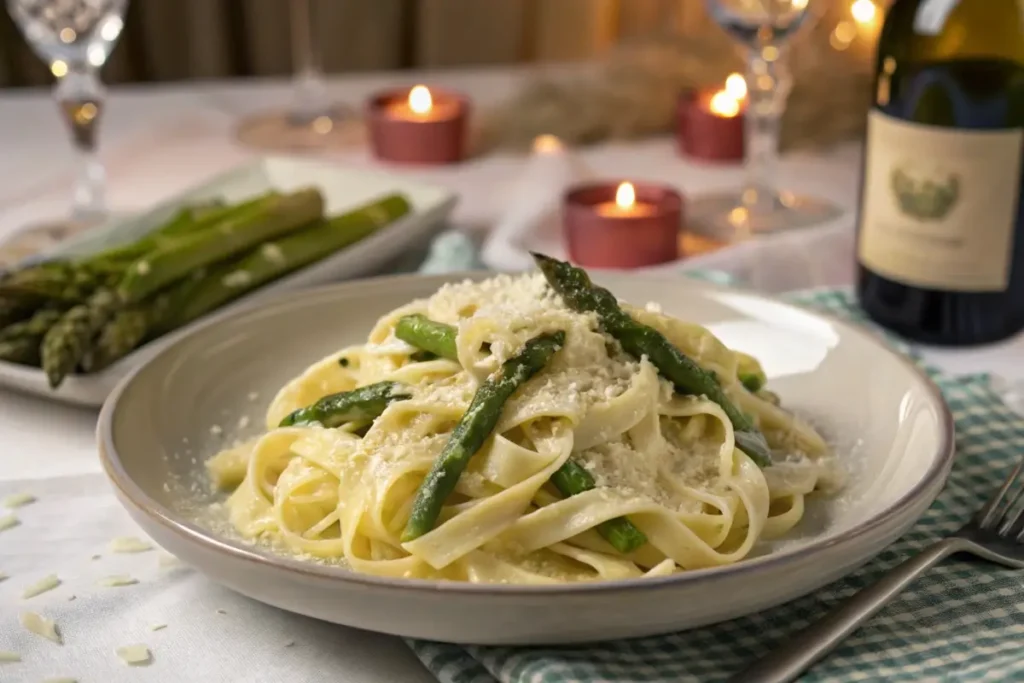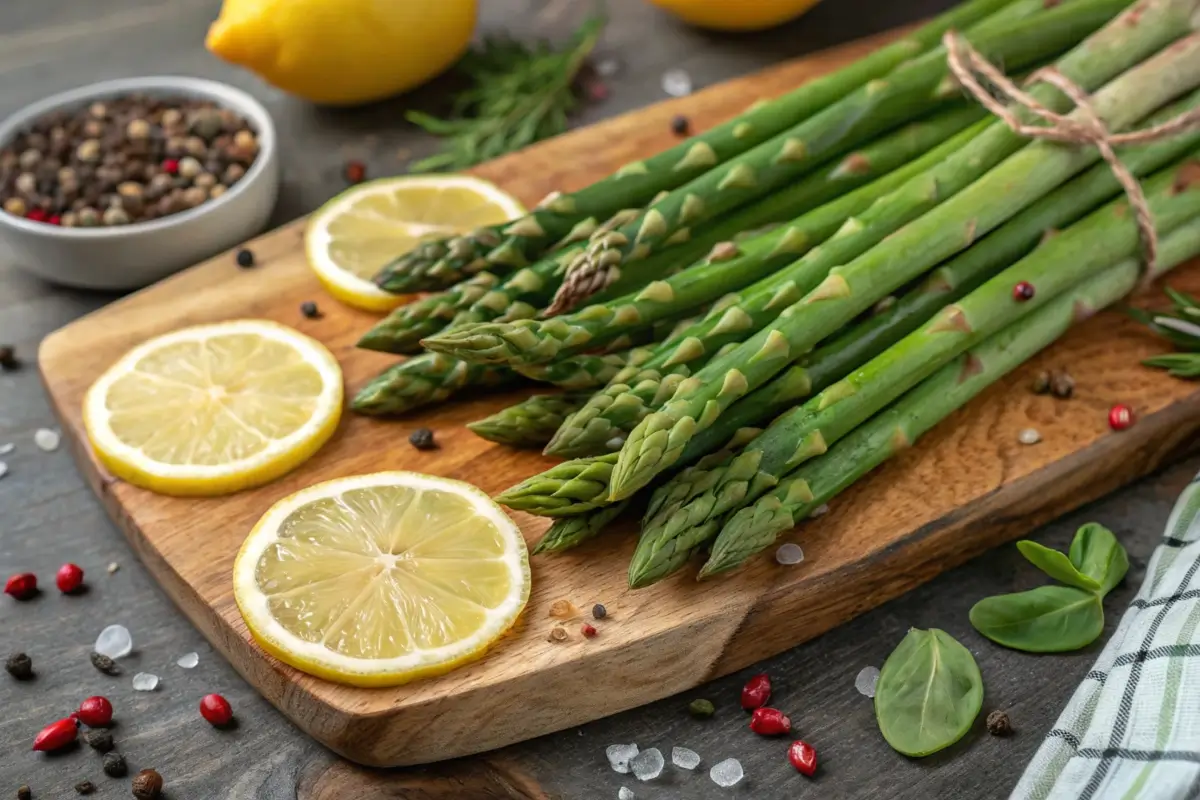Table of Contents
What Cooking Method Is Best for Asparagus?
Asparagus is a go-to vegetable for health enthusiasts—and for good reason! This slender green stalk is not only visually appealing but also a nutritional powerhouse. Understanding the best cooking method for asparagus can help you unlock its vibrant flavors and maximize its health benefits.
Picture this: you’re preparing a meal for friends or family, and you want to wow them with something fresh, flavorful, and nutritious. Enter asparagus! It’s versatile, easy to prepare, and works beautifully with various cooking methods. But which one is the best for enhancing both flavor and nutrition? Let’s explore!
Nutritional Benefits of Asparagus
Asparagus is like that friend who’s great at multiple things—healthy and versatile! It’s low in calories and packed with essential vitamins and minerals, making it a fantastic choice when considering the best cooking method for asparagus.
Vitamins and Minerals Found in Asparagus
Here’s a quick rundown of the nutritional facts:
| Nutrition Facts | Quantity per 100g |
|---|---|
| Calories | 20 |
| Protein | 2.2g |
| Total Fat | 0.2g |
| Carbohydrates | 3.7g |
| Dietary Fiber | 2.1g |
| Vitamin A | 756 IU |
| Vitamin C | 5.7mg |
| Vitamin K | 41.6mcg |
| Folate | 52mcg |
Isn’t that impressive? Asparagus is high in fiber, which helps with digestion, and it’s loaded with vitamins A, C, E, and K—perfect for keeping our bodies in tip-top shape.
Health Benefits of Incorporating Asparagus in Your Diet
Eating asparagus can have some fantastic health upsides! It’s known for its antioxidant properties, which help fight off free radicals—those pesky things that can damage cells. Additionally, it’s a natural diuretic, meaning it can help flush out excess water and salt. Isn’t that cool?
When you include asparagus in your diet, you’re not just enjoying a tasty meal; you’re also supporting your heart health and keeping your skin glowing. Talk about a win-win situation!
Finding the Best Cooking Method
Now, let’s get to the juicy part: how to cook this lovely veggie. There are several methods to choose from when looking for the best cooking method for asparagus, and each has its pros and cons. Let’s break it down.
Boiling Asparagus: Is This the Best Cooking Method for You?
Boiling is perhaps the most straightforward method. You simply throw the asparagus into a pot of boiling water and let it cook for a few minutes. But is it the best way?
Pros of Boiling Asparagus
- Quick and Easy: Boiling takes hardly any time, making it a good option if you’re in a hurry.
- Soft Texture: If you like your asparagus softer (especially good for soups), boiling is the way to go.
Cons of Boiling Asparagus
- Nutrient Loss: The downside is that boiling can wash away some of the vitamins.
- Infusion of Flavor: You might lose some of that lovely earthy flavor asparagus has while boiling it.
Steaming Asparagus: A Nutrient-Packed Choice
If you’re looking for a method that retains more nutrients, steaming is your friend and can be considered one of the best cooking methods for asparagus.
Pros of Steaming Asparagus
- Retains Nutrients: Since the asparagus doesn’t touch the water, it keeps most of its vitamins. Yay for healthy cooking!
- Crisp Tenderness: You can achieve that perfect crunchy yet tender texture.
Cons of Steaming Asparagus
- Equipment Required: You need a steamer basket or an electric steamer.
- Timing: You have to keep an eye on the clock to avoid overcooking.
Roasting Asparagus for Maximum Flavor
Roasting is another popular method that brings out the sweetness of asparagus and enhances its flavors.
Pros of Roasting Asparagus
- Enhanced Flavor: Cooking at high heat caramelizes the sugars in asparagus, giving it a delicious, smoky flavor.
- Versatile Cooking: You can toss it with your favorite herbs and spices.
Cons of Roasting Asparagus
- Longer Cook Time: Roasting takes longer compared to boiling or steaming.
- Requires Oven Space: You need to be mindful of your oven’s real estate when preparing meals.
Grilling Asparagus
Grilling can add a whole new level of flavor to asparagus, making it a favorite when considering the best cooking method for asparagus.
Pros of Grilling Asparagus
- Smoky Flavor: The char from the grill adds a unique taste that’s hard to resist.
- Beautiful Presentation: Grilled asparagus looks amazing on the plate!
Cons of Grilling Asparagus
- More Hands-On: You need to monitor it closely to avoid mushy stalks.
- Weather Dependent: If it’s raining, you might end up with soggy asparagus.
Comparing Cooking Methods
Let’s take a step back and compare these methods in terms of flavor, texture, and nutrient retention.
Flavor Profiles of Each Method
- Boiling: Mild, sometimes washed out.
- Steaming: Fresh, vibrant, and retains most flavors.
- Roasting: Deep, rich flavor; sweet and smoky.
- Grilling: Intense, charred flavor; great for outdoor meals.
Texture Differences Across Cooking Techniques
- Boiled: Soft.
- Steamed: Crisp-tender.
- Roasted: Tender with crispy edges.
- Grilled: Slightly charred and crispy.
Common Cooking Challenges
Even with the best cooking method for asparagus, challenges may arise in your culinary endeavors. Here are some problems you might encounter when preparing this delightful vegetable.
Overcooking and Its Effects on Asparagus Quality
Nothing is worse than overcooked asparagus. When using the best cooking method for asparagus, you want to maintain that vibrant green color. Overcooking can cause the asparagus to lose its bright hue, turning dull and the stalks becoming mushy. This not only affects the texture but also diminishes the delicious flavor that well-cooked asparagus offers!
Underseasoning Your Asparagus Dish
While asparagus is naturally delicious, using the best cooking method for asparagus also involves proper seasoning. If you neglect to add seasoning, the final dish may taste bland and unappealing. Experimenting with different spices and seasonings can elevate the natural taste and enhance your asparagus dish, ensuring it is more appetizing.
Choosing the Right Fresh Asparagus for Optimal Cooking
Using the best cooking method for asparagus starts with selecting the freshest ingredients. Have you ever brought home a bunch of asparagus only to find it wilting? Knowing how to pick the freshest asparagus can significantly affect the outcome of your dish. Look for firm, straight stalks with tight tips. This attention to detail ensures that your chosen cooking method yields a delightful result.
Solutions and Tips for Perfectly Cooked Asparagus
Let’s turn those cooking pitfalls into opportunities for deliciousness with the best cooking method for asparagus! Here are some handy tips to ensure your asparagus stands out:
Timing and Temperature Control Tips for Asparagus Cooking
- Boiling: About 3-4 minutes, depending on thickness.
- Steaming: Around 5-7 minutes.
- Roasting: 15-20 minutes at 400°F (200°C).
- Grilling: Keep it on high for about 5-8 minutes, turning occasionally.
“Timing is everything in cooking. Overdo it, and you might ruin what could’ve been a great dish!”
Seasoning Guidelines for Asparagus
Don’t hold back on the seasoning! A pinch of salt, a dash of lemon juice, or a sprinkle of parmesan can elevate your asparagus dish to restaurant-level goodness. Knowing how to season asparagus is key to mastering the best cooking method for asparagus.
Creative Ways to Serve Asparagus
Now that we’ve covered the essentials of cooking asparagus using the best cooking method for asparagus, let’s talk about how to make it shine on your dinner table. It’s not just a side dish; it can be the star of your meal! Here are some creative ways to impress your friends and family.
Asparagus in Salads
Asparagus can add a fresh crunch and vibrant color to salads. Try this simple recipe:

Grilled Asparagus Salad
Ingredients:
- 1 bunch of asparagus, trimmed
- 2 tablespoons olive oil
- Salt and pepper to taste
- 1 cup cherry tomatoes, halved
- ½ cup feta cheese, crumbled
- Fresh basil leaves, for garnish
Instructions:
- Preheat your grill.
- Toss the asparagus with olive oil, salt, and pepper.
- Grill for about 5-6 minutes until tender and charred.
- In a bowl, combine the grilled asparagus, cherry tomatoes, and feta cheese.
- Garnish with basil leaves and serve fresh!
This salad is not just delicious but also packed with nutrients, balancing the health benefits of asparagus with the refreshing flavors of tomatoes and cheese. Give it a try at your next gathering!
Asparagus in Pasta Dishes
Looking for a hearty meal with a green kick? Asparagus can jazz up your pasta dishes effortlessly. Here’s an easy recipe to whip up:

Asparagus Fettuccine Alfredo
Ingredients:
- 8 oz fettuccine pasta
- 1 bunch of asparagus, cut into bite-sized pieces
- 1 cup heavy cream
- ½ cup parmesan cheese, grated
- 2 tablespoons butter
- Salt and pepper to taste
- Fresh parsley, for garnish
Instructions:
- Cook the fettuccine according to package directions. Add asparagus to the boiling water in the last 3-4 minutes.
- Drain pasta and asparagus, reserving a bit of the pasta water.
- In a saucepan, melt butter over medium heat. Stir in the heavy cream and allow it to simmer for 2-3 minutes.
- Add parmesan cheese and mix until melted and creamy. If the sauce is too thick, add a bit of the reserved pasta water.
- Toss in the fettuccine and asparagus. Season with salt and pepper.
- Serve warm, garnished with fresh parsley.
This creamy, dreamy dish is bound to be a hit! Imagine plating it with perfectly al dente pasta and vibrant green asparagus—talk about comfort food!
Conclusion:
At this point, you may be wondering: what’s the best cooking method for asparagus? Well, that really depends on your personal taste and what you’re aiming for in your dish!
Personal Preferences and Dietary Considerations
Some people love the charred taste of grilled asparagus, while others prefer the gentle crispness of steamed. For those looking to maximize nutrition, steaming might be your best bet. If you’re preparing for a large gathering, roasting can yield a crowd-pleasing batch quickly.
What’s important is to consider the balance of flavor, texture, and nutrition that suits your lifestyle. Experiment! Cooking is all about finding what you enjoy most.
FAQs About Cooking Asparagus
- How do I know when asparagus is cooked perfectly?
Perfectly cooked asparagus should be bright green and tender yet still have a bit of crunch. If you prefer it softer, simply adjust your cooking time accordingly. - Can I eat asparagus raw?
Absolutely! Raw asparagus can be sliced thinly and tossed in salads for a delightful crunch. Just be sure to choose fresh, young stalks for the best flavor. - What’s the best way to store leftover asparagus?
Store it in an airtight container in the fridge, preferably standing upright in a glass of water (like fresh flowers!). This can help it stay crisp longer. - Are there different types of asparagus?
Yes! The most common types are green, white, and purple asparagus. Each has its own flavor profile and can be used interchangeably in recipes based on your preference.
As you can see, asparagus is a versatile and nutritious vegetable that can be prepared in many delightful ways. So go ahead, grab that bunch of asparagus at the store, and give it a whirl in your kitchen. Who knows? You might just find your new favorite dish!
Thank you for joining me on this asparagus adventure! Happy cooking!

